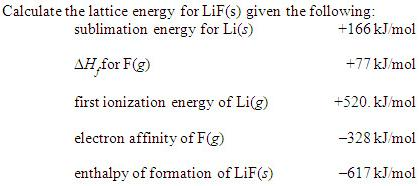


The melting point The temperature at which the individual ions in a lattice or the individual molecules in a covalent compound have enough kinetic energy to overcome the attractive forces that hold them together in the solid., for example, is the temperature at which the individual ions have enough kinetic energy to overcome the attractive forces that hold them in place. The magnitude of the forces that hold an ionic substance together has a dramatic effect on many of its properties. The Relationship between Lattice Energies and Physical Properties The order of increasing lattice energy is RbCl ZnS > SrSe > LiCl > KBr Because the cation and the anion in BaS are both larger than the corresponding ions in CaO, the internuclear distance is greater in BaS and its lattice energy will be lower than that of CaO. Because Ba 2+ lies below Ca 2+ in the periodic table, Ba 2+ is larger than Ca 2+. To decide whether BaS or CaO has the greater lattice energy, we need to consider the relative sizes of the ions because both compounds contain a +2 metal ion and a −2 chalcogenide ion. Consequently, we expect RbCl, with a (−1)(+1) term in the numerator, to have the lowest lattice energy, and GaP, with a (+3)(−3) term, the highest. We know from Equation 8.4 that lattice energy is directly proportional to the product of the ionic charges. The compound GaP, which is used in semiconductor electronics, contains Ga 3+ and P 3− ions the compound BaS contains Ba 2+ and S 2− ions the compound CaO contains Ca 2+ and O 2− ions and the compound RbCl has Rb + and Cl − ions. For compounds with ions with the same charge, use the relative sizes of the ions to make this prediction. Using Equation 8.4, predict the order of the lattice energies based on the charges on the ions.

#Lattice energy equation ke series#
A similar effect is seen when the anion becomes larger in a series of compounds with the same cation.Īrrange GaP, BaS, CaO, and RbCl in order of increasing lattice energy.Īsked for: order of increasing lattice energy Because r 0 in Equation 8.4 is the sum of the ionic radii of the cation and the anion ( r 0 = r + + r −), r 0 increases as the cation becomes larger in the series, so the magnitude of U decreases. This effect is illustrated in Figure 8.2 "A Plot of Lattice Energy versus the Identity of the Halide for the Lithium, Sodium, and Potassium Halides", which shows that lattice energy decreases for the series LiX, NaX, and KX as the radius of X − increases. For example, the calculated value of U for NaF is 910 kJ/mol, whereas U for MgO (containing Mg 2+ and O 2− ions) is 3795 kJ/mol.īecause lattice energy is inversely related to the internuclear distance, it is also inversely proportional to the size of the ions. Source: Data from CRC Handbook of Chemistry and Physics (2004).īecause the lattice energy depends on the product of the charges of the ions, a salt having a metal cation with a +2 charge (M 2+) and a nonmetal anion with a −2 charge (X 2−) will have a lattice energy four times greater than one with M + and X −, assuming the ions are of comparable size (and have similar internuclear distances). Note that r 0 may differ between the gas-phase dimer and the lattice. In such an arrangement each cation in the lattice is surrounded by more than one anion (typically four, six, or eight) and vice versa, so it is more stable than a system consisting of separate pairs of ions, in which there is only one cation–anion interaction in each pair.

While Equation 8.1 has demonstrated that the formation of ion pairs from isolated ions releases large amounts of energy, even more energy is released when these ion pairs condense to form an ordered three-dimensional array ( Figure 7.8 "Definition of Ionic Radius"). These properties result from the regular arrangement of the ions in the crystalline lattice and from the strong electrostatic attractive forces between ions with opposite charges. They are not easily deformed, and they melt at relatively high temperatures. Ionic compounds are usually rigid, brittle, crystalline substances with flat surfaces that intersect at characteristic angles. Recall from Chapter 2 "Molecules, Ions, and Chemical Formulas" that the reaction of a metal with a nonmetal usually produces an ionic compound that is, electrons are transferred from the metal (the reductant) to the nonmetal (the oxidant). To use the Born–Haber cycle to calculate lattice energies.To understand the relationship between the lattice energy and physical properties of an ionic compound.


 0 kommentar(er)
0 kommentar(er)
